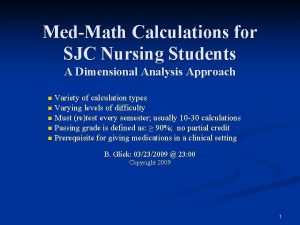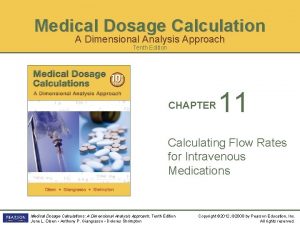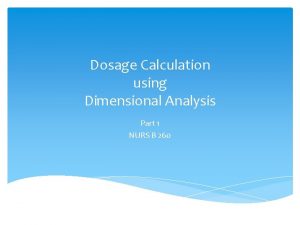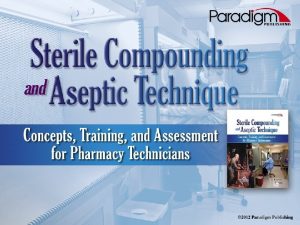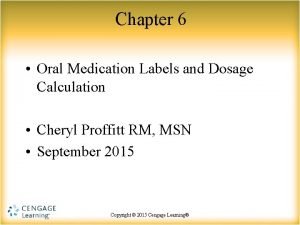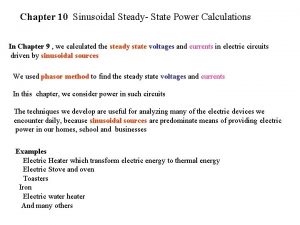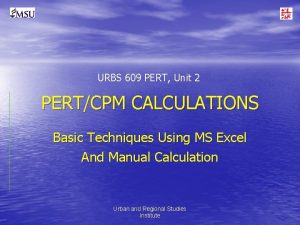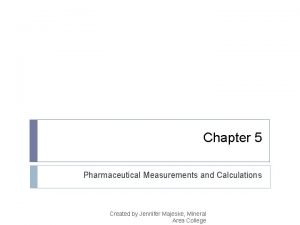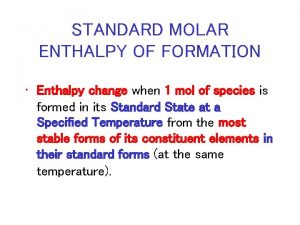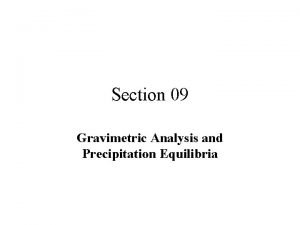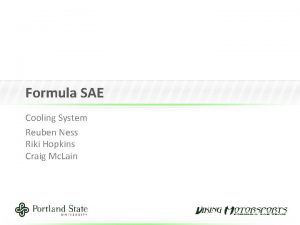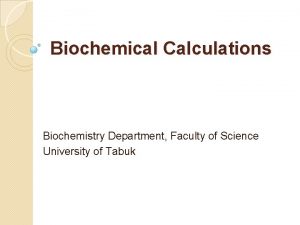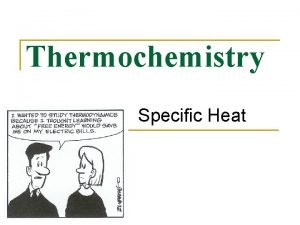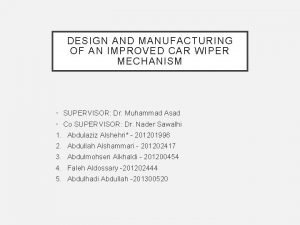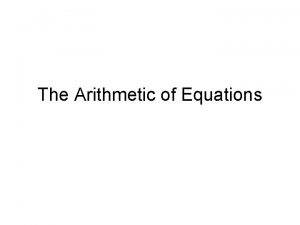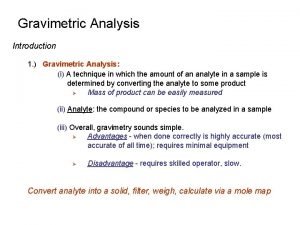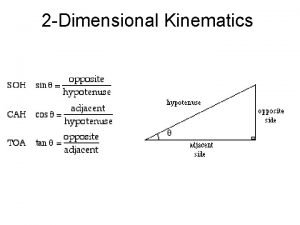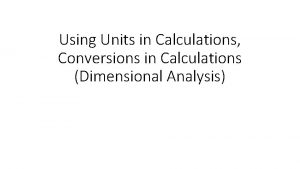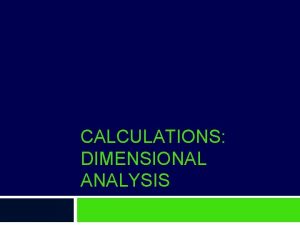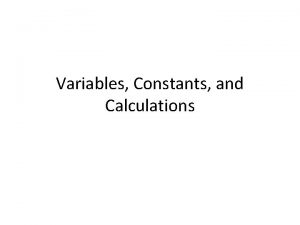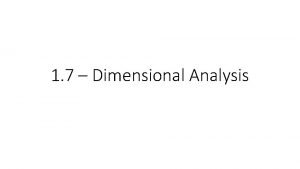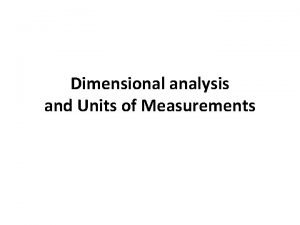MedMath Calculations for SJC Nursing Students A Dimensional

































































![Easily solved problems with answers – [in brackets] Supply: 5 mg/m. L. Order: 50 Easily solved problems with answers – [in brackets] Supply: 5 mg/m. L. Order: 50](https://slidetodoc.com/presentation_image/224918d7c78df0e570438547ddfa9657/image-66.jpg)













































- Slides: 111

Med-Math Calculations for SJC Nursing Students A Dimensional Analysis Approach Variety of calculation types n Varying levels of difficulty n Must (re)test every semester; usually 10 -30 calculations n Passing grade is defined as: ≥ 90%; no partial credit n Prerequisite for giving medications in a clinical setting n B. Glick: 03/23/2009 @ 23: 00 Copyright 2009 1

Table of Contents n n n Introductory text. . . 1 Problems solved in class. . . . 19 Easily solved problems (outside class). . . 66 More solved problems (outside class). . . 68 Answers to More solved problems. . . . 2 93

Why are you learning to make these calculations? It is physically impossible to stock every medication in every possible dosage. n APRNs & physicians don’t know (or care) what is in your medication inventory. n Nurse must ACCURATELY do the arithmetic to use what is in the inventory and convert it to what the physician or APRN ordered. n 3

The nurse’s most important role in medicating a patient n The nurse is the patient’s last line of defense against receiving an inappropriate medication. Right patient? Right medication? Right time? Right route? Right dose? Right form? Expiration date? 4

Arguments for/against using dimensional analysis n For: Formulas are derived from dimensional analysis. If you forget the formula, you have no rational backup. Guessing is not rational! n For: By canceling the excess labels before doing the arithmetic, the problem setup is very likely to be correct. (Avoids the generation of an inappropriate or nonsense answer such as: m. L 2) n Against: Dimensional analysis is more work than using formulas. 5

Med-Math question types & sample units of measure Intake/output n Counting (tablets, units of medication) n Mass (weight) n Volume (m. L, Liter) n Rate (drops/min, m. L/hr, mg/min, units/hr) n Time-based (what time will the IV bag empty? ) n Reconstitution – Junior level nursing students n IV rate changes - Junior level nursing n 6

Time Abbreviations – Use of the “q” abbreviation is discouraged, but remains prevalent. q 4 h – every 4 hours n q 8 h – every 8 hours n q 12 h – every 12 hours n qd – every day (1 time/day) n bid – every 12 hours (two times a day) n tid – every 8 hours (three times a day) n 7

Other Abbreviations Mass (weight): microgam (mcg) milligram (mg) gram (g) kilogram (Kg) pounds (lbs, #) n Volume: milliliter (m. L) = (cc) do not use “cc” liter (L) teaspoon (tsp) ounce (oz) tablespoon (tbs) cup (C) n 8

Other Abbreviations continued Time: hour (h, hr) minute (min) n Count: tablet (tab) drop = gtt [Latin: gutta or guttae] (singular plural) Unit [quantity of certain medications] m. Eq [milliequivalents for electrolytes] tablet n 9

Rate definition Rate = flow (These two words mean the same thing) How much medication AND how quickly? n Volume & Time (gtt/min, m. L/hr) n Mass & Time (mg/min) n Counting & Time (tablets/dose, Units/hr) n m. L/hr is the default flow for IV pumps 10

Graphic representation of grams, milligrams and micrograms 11

Introduction to problem solving n Answer exactly what you are being asked to find. Not what you think the question means. n Not what you think the question should ask. n n Determine the label for the answer. NOTE: The answer label should be, but may not always be explicitly stated in the problem. Example: IV flow through a pump implies m. L/hr. 12

Problem solving strategy (1) Based upon the question, determine what the answer’s label will be and place it to the right of the previous lines. Then place an equal sign (=) to the right of the label. (2) The numerator of term immediately to the right of the answer’s numerator label must match the answer’s numerator label. You may require a conversion factor such as (1, 000 mcg/1 mg) to force the correct label in the 1 st numerator. 13

Problem solving strategy (3) If the question asks you to find (for example) m. L/hr, set up the following generic statement. The intention is to cascade as many labels as you need so that the labels that do not appear in the answer are arithmetically canceled. (x to x, y to y and z to z; leaving m. L per hr, as required in the answer) m. L = m. L * x * y * z hr x y z hr 14

Problem solving strategy n Include medication order, medication source and other factors to cancel labels that are not used in the answer. (examples that may be relevant: patient weight, drip set ratio, time factors and conversions) n Notice that all parts of the formula contain PAIRS of data. Examples: gtt/m. L, mg/hr, mg/m. L, g/L, “something”/dose, mg/Kg/day n By definition: a microdrip set = 60 ggt/m. L By definition: a macrodrip set = 10, 15 or 20 gtt/m. L n 15

Rounding Rules. Always follow special directions in the question. n Verify the rounding rules with your instructor. Typical rules follow: Infant & Pediatric: calculate final answer to 3 places to right of decimal; then round back to 2 places. Follow the 5/4 rule: Value on dashed line affects solid lines. _______. ___ ---n Adult: calculate final answer to 2 places to right of decimal; then round back to 1 place. Follow the 5/4 rule: Value on dashed line affects solid lines. _______. ___ ---n Drops (gtt) and Units [medication] are always rounded to the nearest whole number. Follow the 5/4 rule: Value on dashed line affects solid lines. 16 _______. n

Problem with an explicit answer Order: 400 mg of med. Supply: 125 mg per 5 m. L. How many m. L will you give? 5 m. L * 400 mg ? m. L = ------ 125 mg 1 an number over “ 1” makes the numerator obvious & does not 17 = 16 m. L change the numerator’s

Problem with an implied answer Order: 400 mg of med. Supply: 125 mg per 5 m. L. 5 m. L * 400 mg ? m. L = -------- 125 mg 1 = 16 m. L All further examples are typed on these slides as follows: m. L = (5 m. L/125 mg) * (400 mg/1) = 16 m. L 18

Class Problem mg/min Determine the mg/min required to administer when the flow and solution concentration are given. The medication is infusing at 32 m. L/hr. The IV volume is 250 m. L. The amount of dissolved medication is 700 mg. If necessary, round answer to 1 decimal place. See next slide for important considerations. 19

Class Problem mg/min Identify the pairs of data: 250 m. L & 700 mg 1 hour and 32 m. L Orient the pairs as required to satisfy the answer’s label and cancel all other labels. Which conversion “tool” will you use to change the hours to minutes? 20

Answer - mg/min Determine the mg/min required to administer when the flow and solution concentration are given. The medication is infusing at 32 m. L/hr. The IV volume is 250 m. L. The amount of dissolved medication is 700 mg. mg/min=(700 mg/250 m. L) * (32 m. L/hr) * (1 hr/60 min) = 1. 49 Round up to 1. 5 mg/min ___1____. _4__ --9 -- mg/min rounds to: ___1____. _5__ - mg/min 21

Class Problem – mcg/min Determine how many mcg/min are infusing if the IV contains 240 mg of medication per 500 m. L and is infusing at 16 m. L/hr. If necessary, round answer to 1 decimal place. This problem does not have mcg in any of the data; therefore, put a conversion “tool’ for mcg and mg immediately to the right of the equal sign (=). Then cascade and orient the rest of the data so that labels not appearing in the answer’s label are canceled. 22

Answer – mcg/min Determine how many mcg/min are infusing if the IV contains 240 mg of medication per 500 m. L and is infusing at 16 m. L/hr mcg/min = (1000 mcg/mg) *(240 mg/500 m. L) * (16 m. L/hr) * (hr/60 min) = 218 mcg/min 23

Class Problem – m. L/hr The provider has ordered 2 mcg/min. The nurse has 5 mg per 250 m. L. The flow rate is _________ m. L/hr. If necessary, round answer to 1 decimal place. 24

Answer – m. L/hr The provider has ordered 2 mcg/min. The nurse has 5 mg per 250 m. L. The flow rate is _________ m. L/hr = (250 m. L/5 mg) * (1 mg/1000 mcg) * (2 mcg/min)* (60 min/1 hr) = 6 m. L/hr 25

Class Problem – m. L/hr The provider ordered a medication at the rate of 46 mcg/Kg/min. The client weighs 72. 7 Kg. The medication is supplied as 300 mg in 75 m. L of solution. The client should receive _______m. L/hr. If necessary, round answer to 1 decimal place. When using a 3 -part component (e. g. , mcg/Kg/min), always use the 1 st component in the numerator (mg) and everything else in the denominator. For example: mg 26

Answer – m. L/hr The provider ordered a medication at the rate of 46 mcg/Kg/min. The client weighs 72. 7 Kg. The medication is supplied as 300 mg in 75 m. L of solution. The client should receive _______m. L/hr = (75 m. L/300 mg) * (1 mg/1000 mcg) * (46 mcg/Kg/1 min) * (72. 7 Kg/1) * (60 min/1 hr) = 50. 163 rounds up to 50. 2 m. L/hr 27

Class Problem - tablets A medication comes out of the bottle as 2. 5 mg/tablet. Give 2. 5 mg tid. If necessary, round answer to 1 decimal place. (1) How many tablets/dose? (2) How many tablets daily? 28

Answer - tablets A medication comes out of the bottle as 2. 5 mg/tablets. Give 2. 5 mg tid. (1) How many tablets/dose? (Each 1 dose = 2. 5 mg. ) tabs/dose = (1 tab/2. 5 mg) * (2. 5 mg/1 dose) = 1 tablet/dose (2) How many tablets daily? (tid = 3 doses/day) tabs/day = (1 tab/2. 5 mg) * (2. 5 mg/dose) * (3 doses/day) = 3 tablet/day 29

Class Problem – mg/day The provider ordered 2 mg/Kg/day IV for a 16 pound infant. The infant should receive _______mg per day. If necessary, round answer to 2 decimal places. 30

Answer – mg/day The provider ordered 2 mg/Kg/day IV for a 16 pound infant. The infant should receive _______mg per day. mg/day = (2 mg/Kg/day) * (1 Kg/2. 2 lbs) * (16 lbs/1) =14. 545 round up to 14. 55 mg/day 31

Class Problem – determine the label and solve the problem A medication is ordered for your patient at 80 mg/Kg/24 hours every 8 hours. The child weighs 18 lbs. How many mg of medication will you administer at each dose? If necessary, round answer to 1 decimal place. 32

Answer – determine the label and solve the problem A medication is ordered for your patient at 80 mg/Kg/24 hours every 8 hours. The child weighs 18 lbs. How many mg of medication will you administer at each dose? mg/dose= (80 mg/Kg/24 hrs) * (8 hrs/dose) * (1 Kg/2. 2 lbs) * (18 lbs/1) = 218. 182 rounds down to 218. 2 mg/dose 33

Class Problem – gtt/min Calculate the drip rate of 1, 000 m. L of medication to infuse over 10 hours using an infusion set that delivers 15 gtt/m. L. How many drops/min? If necessary, round answer to 1 decimal place. 34

Answer – gtt/min Calculate the drip rate of 1, 000 m. L of medication to infuse over 10 hours using an infusion set that delivers 15 gtt/m. L. gtt/min= (15 gtt/m. L) * (1, 000 m. L/10 hrs) * (1 hr/60 min) = 25 gtt/min 35

Expectation 4 AM 5 AM 6 AM 7 AM 8 AM 9 AM 1 Liter bag of medication 10 AM What is observed 1, 000 m. L 900 m. L ? m. L 800 m. L ? m. L 700 m. L ? m. L 600 m. L ? m. L 500 m. L ? m. L 400 m. L 600 m. L Drip chamber 7 tubing To the patient 36

Class Problem – Is the IV setup working as expected? The IV above was started at 4 AM. n At 10 AM 600 m. L remain in the bottle. n Is the IV running on time? (Refer to previous slide for m. L/hr) n 37

Answer – Is the IV setup working as expected? n n n The IV above was started at 4 AM. At 10 AM 600 m. L remain in the bottle. Is the IV running on time? (4 AM to 10 AM) = 6 hrs running time. (1, 000 m. L/10 hrs) = 100 m. L/hr. (100 m. L/hr * 6 hrs/1) = 600 m. L should be used in 6 hours. (1, 000 m. L – 600 m. L) = 400 m. L should still be in the bottle. Therefore: bottle is emptying too slowly – NO: not on time. Patient may have laid on the tubing and caused it to 38

Conversion factors to memorize n 1 oz = 30 m. L n 8 oz = 1 cup = 240 m. L n =========== n 16 oz = 1 pint = 500 m. L n 32 oz = 1 quart = 1, 000 m. L = 1 liter n 128 oz = 1 gallon = 4, 000 m. L 39

Class Problem – Intake & Output 12 hour I/O for patient Smith on 4/7/2008: 4 oz cranberry juice 175 m. L urine 1/2 cup oatmeal 2 slices of toast 120 m. L yellow vomit 8 oz black coffee a tuna fish sandwich 1/2 cup flavored gelatin 100 m. L diarrhea 3 oz cream of mushroom soup 6 oz 1% milk 230 m. L urine 16 oz water 1 pint ice cream 2 tsp liquid medication 1 tbs liquid medication IV @ 150 m. L for 3 hrs 1 cup applesauce What is the intake? _______ What is the output? _______ 40

Answer - Intake 4 oz cranberry juice 4 oz * 30 m. L/oz = 120 m. L 8 oz black coffee 8 oz * 30 m. L/oz = 240 m. L 1/2 cup flavored gelatin 4 oz * 30 m. L/oz = 120 m. L 3 oz cream of mushroom soup 3 oz * 30 m. L/oz = 90 m. L 6 oz 1% milk 6 oz * 30 m. L/oz = 180 m. L 16 oz water 1 pint = 500 m. L 1 pint ice cream 1 pint = 500 m. L 2 tsp liquid medication 2 tsp * 5 m. L/tsp = 10 m. L 1 tbs liquid medication 1 tbs * 15 m. L/tbs = 15 m. L IV @ 150 m. L for 3 hrs 150 m. L/hr * 3 hr = 450 m. L 1 cup applesauce 1 cup * 16 oz/cup = 240 m. L Answer: - -------------------- 2, 465 m. L 41

Answer - Output & Net gain or loss 175 m. L urine 120 m. L yellow vomit 230 m. L urine 100 m. L diarrhea Input = 2, 465 m. L 625 m. L Output Output = 625 m. L Net gain = 1, 840 m. L More fluid was retained than was excreted; therefore, patient has a net gain. 42

Class Problem m. L/hr with distracters This problem contains distracters. Determine what the answer label is. Then look to see which components of the question will satisfy the requirements for the answer’s label. Ignore everything else. If necessary, round answer to 1 decimal place. An IV of 1, 000 m. L medication contains 60 m. Eq of an electrolyte and is set to infuse at 27 drops per minute. The tubing delivers 10 gtts/cc. How many m. L/hr are you administering? 43

Answer - m. L/hr with distracters An IV of 1, 000 m. L medication contains 60 m. Eq of an electrolyte and is set to infuse at 27 drops per minute. The tubing delivers 10 gtts/cc. How many m. L/hr are you administering? Be in the habit of rewriting drops to gtt and cc to m. L. n Remember to find pairs of data that may work for you. 27 gtt/min 10 gtt/m. L m. L/hr 1, 000 m. L/m. Eq n Correct answer: m. L/hr = (1 ml/10 gtt) * (27 gtt/1 min) * (60 min/1 hr) = 162 m. L/hr Why is this wrong? m. L/hr = (1, 000 ml/60 m. Eq) * (27 gtt/1 min) * (60 min/1 hr) 44

Class Problem – Time-based Unless otherwise specified, and if necessary, round answer to 1 decimal place. 900 m. L of medication is ordered to infuse at 80 m. L per hour. (1) Assuming that there are no interruptions, how long will it take to empty the bag? (2) If the IV line is started at 2: 47 PM, what time will the bag run dry? 45

Answer - Calculate the hours 1) Assuming that there are no interruptions, how long will it take to empty the bag? Hours = (1 hr/80 m. L) * ( 900 m. L/1) = 11. 25 hours This answer is expressed in hours and it means 11 and ¼ hours. It is NOT 11 hours and 25 minutes! 46

Answer - Calculate the minutes minutes = (60 min/1 hr) * (0. 25 hr/1) = 15 minutes 47

Answer – total run time expressed in hours & minutes (1) Assuming that there are no interruptions, how long will it take to empty the bag? The bag will empty in 11 hours and 15 min. 48

Answer - Time bag will theoretically empty (2) If the IV line is started at 2: 47 PM, what time will the bag run dry? (from previous page) 2 PM + 11 hours -------> 1 AM 47 minutes + 15 minutes = 62 minutes 1 AM + 62 minutes ------> 2: 02 AM 49

Class Problem – Reconstitution problems ask the nurse to dissolve a drug (typically a powder) whose quantity is usually expressed in grams or milligrams in: a specific quantity of a liquid (usually measured in milliliters). Frequently, the liquid is normal saline (0. 9% NS) or D 5 W. Conceptually, this is identical to dissolving 1 teaspoon of table salt in 1 cup of hot water. 50

Class Problem – Reconstitution Order: 350 mg of the drug to be given q 8 h IV. How many m. L will you give per dose? Supply: The drug is available in 500 mg containers. The label tells the nurse to dissolve the powder in 25 m. L of normal saline (NS). 51

Class Problem – Reconstitution Which pairs of data do you find in the problem? n 350 mg every 8 hours. (every 8 hours means: 1 dose. ) n 500 mg of the powder is dissolved in 25 m. L of NS. What is the answer’s label for your calculation? n How many m. L/dose? Can you isolate all of the components that are required to solve this problem? (YES, of course you can 52

Answer – Reconstitution m. L/dose = (25 m. L/500 mg) * (350 mg/dose) = 17. 5 m. L/dose 53

Class Problem – Reconstitution Order: 250 mg of the drug to be given q 8 h IV. How many m. L will you give per dose? Supply: The drug is available in 1 g containers. The label tells the nurse to dissolve the powder in 50 m. L of normal saline (NS). The disconnect is between the grams and the milligrams, so use the appropriate conversion “tool. ” 54

Answer – Reconstitution m. L/dose = (50 m. L/1 g) * (1 g/1000 mg) * (250 mg/dose) = 12. 5 m. L/dose 55

Class Problem – Reconstitution Order: 20 mg/Kg of the drug to be given q 8 h IV. Patient weighs 50 pounds. How many m. L will you give per dose? Supply: The drug is available in 500 mg containers. The label tells the nurse to dissolve the powder in 5 m. L of normal saline (NS). With which data pair is the “dose” a factor? Why? 56

Answer – Reconstitution m. L/dose = (5 m. L/500 mg) * (20 mg/1 Kg/1 dose) * (1 Kg/2. 2 lbs) * (50 lbs/1) = 4. 545 rounds up to 4. 55 m. L/dose Dose is only related mg/Kg. Any other pair does not make any sense. 57

Class Problem – Reconstitution Order: 700, 000 Units given IM. How many m. L will you give? Supply: The drug is available in 5, 000 Unit containers. The label tells the nurse to reconstitute (dissolve) the powder in 3. 2 m. L of normal saline (NS) to yield 1, 000 Units/m. L. This problem contains a distracting pair. To determine what the distracting pair is, you must understand the sequence of the problem’s operation. See picture on next slide. 58

Reconstitution Graphic 5 million Units in 3. 2 m. L 1 million Units/1 m. L The patient Which medication source DIRECTLY affects the patient? 59

Answer – Reconstitution The distracters are the 5 million Units and 3. 2 m. L. Your reconstituted supply is now 1 million Units/m. L. The 5 million units dissolved in the 3. 2 m. L is how you arrived at the 1 million Units/m. L. Now they are irrelevant = distractors. m. L = (1 m. L/1, 000 Units) * (7. 000, 000 Units/1) = 0. 7 m. L 60

Class Problem – Reconstitution Order: 500 mg IV every 4 hours. Supply: The drug is available in 1 gram containers. The label tells the nurse to reconstitute (dissolve) the powder in 10 m. L of 0. 9% NS. THEN further dilute this mixture in 50 m. L of NS. Infuse it over 30 minutes. The drip set is 10 gtt/m. L. 61

Class Problem – Reconstitution Refer to the previous graphic and make a similar picture for this problem. Step-A: How many m. L will you use of the 10 m. L in which you dissolve the 500 mg of powder? Step-B: How many m. L/hr will you give the patient? Step-C: How many drops/min? 62

Answer – Reconstitution This is a multi-step (3) problem. (A) Determine how many m. L after mixing the powder (Step-1). m. L = (10 m. L/1 gram) * (1 gram/1, 000 mg) * 500 mg/1) = 5 m. L 63

Answer – Reconstitution (B) Determine how many m. L/hr after diluting the mixture (Step-2). m. L/hr = (55 m. L/30 min) * (60 min/1 hr) = 110 m. L/hr Your picture should tell you why we use 55 m. L, not 50 m. L. 64

Answer – Reconstitution (C) Determine how many gtt/min: gtt/min = (10 gtt/1 m. L) * (110 m. L/1 hr) * (1 hr/60 min) = 18. 3 rounds down to 18 gtt/min 65
![Easily solved problems with answers in brackets Supply 5 mgm L Order 50 Easily solved problems with answers – [in brackets] Supply: 5 mg/m. L. Order: 50](https://slidetodoc.com/presentation_image/224918d7c78df0e570438547ddfa9657/image-66.jpg)
Easily solved problems with answers – [in brackets] Supply: 5 mg/m. L. Order: 50 mg. Tsp____? [2 tsp] Supply: 10 mg tablets. Order: 30 mg. Tablets__? tablets] [3 Supply: 250 mg/5 m. L. Order: 1. 5 g. m. L____? m. L] [30 Supply: 50 mg tablets. Order: 0. 2 g. Tablets__? [4 tablets] Supply: 100 mg/5 m. L. Order: 0. 25 g. m. L____? m. L] [12. 5 Supply: 5 m. L/tsp, tsp contains 250 mg. Order: 0. 5 g . m. L____? [10 m. L] 66

Easily solved problems with answers Supply: 10 m. L/1 million Units. Order: 200, 000 Units. m. L____? [2 m. L] Supply: each tablet contains 0. 25 g. Order: 500 mg. Tabs___? [2 tablets] Supply: 2 m. L per 600, 000 Units. Order: 300, 000 Units. m. L____? [1 m. L] Supply: 0. 1 g per tablet. Order: 200 mg. Tabs____? [2 tablets] Supply: 500 mcg in 1. 5 m. L. Order: 0. 8 mg. m. L____? [2. 4 m. L] 67

More Solved Problems – Unless otherwise instructed, as necessary, round all final answers to 1 decimal place. How many milliliters you will give for each medication? Answers begin on slide 92. 1. Give your patient 0. 1 mcg. Your stock has 1. 5 m. L vials with 0. 3 mcg. 2. Order is for 3, 500 Units. Supply is 8, 500 Units per 1. 5 m. L. 68

More Solved Problems 3. Prepare a 25 m. Eq dose. You have 20 m. Eq dissolved in 10 m. L. 4. Supply is 1 mg/m. L. You are ordered to give 750 mcg. 5. Your inventory contains a bottle with 0. 4 g in 2 m. L. Order is for 300 mg. 69

More Solved Problems 6. Supply is an elixor labeled 3 mg/m. L. Order is for 3 teaspoons. How many milliliters will you give? This dose is equal to how many milligrams? 7. The order is for an oral suspension of 50 mg. your inventory contains 25 mg/5 m. L. How many teaspoons will you give? 70

More Solved Problems 8. Drug comes in 10 mg tablets. APRN orders 30 mg daily. How many tablets will you give over the course of the whole day? How many tabs per dose if the drug is to be given every 8 hours (tid)? 9. Prescribed are 1. 5 mg. Liquid is labeled 250 mg per 5 m. L. How many m. L will you give? 71

More Solved Problems 10. Give your patient 200, 000 Units. Available is a multiple dose vial labeled 1, 000 Units in 10 m. L (cc). How many m. L will you give? 11. You have scored (can be split) tablets labeled 0. 1 g. Your order is for 200 mg every morning. How many tablets, or part of a tablet, will you give? 72

More Solved Problems 12. Prescribed is a 0. 75 mg dose for an infant weighing 8. 7 pounds. The drug is available as 500 mcg dissolved in 1. 5 m. L. How many m. L will you give? 13. 360 mg to be given orally every 4 to 6 hours. Available drug is 180 mg/5 m. L. How many m. L should be given at each dose? 73

More Solved Problems 14. Your patient weighs 60 Kg. Order is for 500 mg of medication daily. Drug package instructions say there are 125 mg/tsp. How many milliliters will you give? 15. Patient weighs 41 pounds. APRN orders 75 mg/Kg/day in 4 divided doses. Drug is available in 175 mg/3 m. L. How many m. L should be give for each dose? 74

More Solved Problems 16. Give 15 mg/Kg/day. Drug is prescribed in 3 evenly spaced doses over 24 hours. Patient weighs 231 pounds. (A) How many hours apart will you give each dose? (B) If the drug is available in units of 75 mg/m. L, how many milliliters will you give per dose? 75

More Solved Problems 17. How many micrograms are in 1 gram? 18. How many m. L in 4 tablespoons? 19. Give 500 m. L of an IV liquid over 8 hours. The drip set is 10 drops/m. L. How many gtt/min will you adjust the manual control on the drip set? 76

More Solved Problems 20. A piggyback IV liquid contains 50 m. L of medication. It is attached to a microdrip set. Deliver the medication over 2 hours. How many drops per minute is this? 21. Referring to the previous problem, what happens to the flow of medication from the main medication bag when the piggyback is running thru the IV line? 77

More Solved Problems 22. An IV drug is administered via a pump. The medication is packaged as 50 mg per 100 m. L of liquid to be given over 2 hours. The drip set package is marked 15 gtt. How many m. L/hour will you set the pump? 23. Using a pump, an IV medication is to be given over 90 minutes. The medication is dispensed from a 250 milliliter bag. How many m. L/hour will you set the pump? 78

More Solved Problems 24. Order is for 16 mcg/Kg. Infuse in 90 minutes. Drug volume is 75 m. L. The patient is a child who weighs 46 pounds. The child should receive 223. 03 mcg at a rate of ____ m. L/hour? 79

More Solved Problems 25. 150 m. L of liquid contains 8 m. Eq of a continuous infusion at 25 ml/hour. The patient will receive how many m. Eq/day? 26. How many mcg/min are being infused if an IV contains 150 mg of medication per 250 m. L and is infusing at 10 m. L/hr? 80

More Solved Problems 27. Calculate the intake expressed in m. L and in liters. Ignore the output. 6 oz orange juice 150 m. L urine 2/3 cup cereal with an additional 4 oz whole milk 3 pancakes covered with 1 oz maple syrup 120 m. L of brownish-yellow vomit 6 oz black coffee with an additional 2 oz 2% milk 1/4 cup orange gelatin 100 m. L diarrhea 3 tbs apple sauce An IV infusing at 150 m. L/hr for 8 hours 2 tsp liquid medicine 2 pills taken with a total of 4 oz water 1 pint sherbet 81

More Solved Problems 28. 450 m. L of medication is ordered to infuse at 52 m. L per hour. (A) Assuming that there are no interruptions, how long will it take to empty the bag? (B) If the IV line is started at 7: 47 PM, 82

More Solved Problems 29. A dehydrated patient is placed on a continuous drip at 15 m. L/hr. The drip set is 15 gtt/m. L. The nurse enters the patient’s bathroom where she observes a toilet mounted hat containing 200 ml of urine. An unlicensed assistant tells the nurse that within the past few minutes he cleaned up 2 times after the patient soiled himself and the bed. Each time about 75 m. L of diarrhea came out. Then the patient 83

More Solved Problems (A) How much fluid was lost? (B) The physician orders the existing drip to continue as ordered PLUS an order to replace the lost fluid over the next hour. How much fluid will the nurse infuse over the next hour? (C) How many drops/minute? 84

More Solved Problems (D) In a separate IV, the patient is receiving 1350 Units/hr of a medication that is dispensed from a 500 m. L bag containing 25, 000 Units of the drug through a micro drip set. How many m. L/hr are being infused? (E) How many drops/minute are being infused? 85

More Solved Problems The physician decides to increase the dosage by 3 Units/Kg/hr. The patient weighs 185 pounds. (F) How many Units/hr will the nurse administer? (G) How many m. L/hour will the pump be set? 86

More Solved Problems (H) How many gtt/min will be infused? (I) How many hours will this IV run? Express as a decimal quantity – 3 decimal places? 87

More Solved Problems (J) How many whole hours will the IV run? (K) How many remaining minutes will there be? (L) This IV started at 8: 57 PM. What time will the bag empty? 88

More Solved Problems (M) An additional IV is ordered to run at 60 m. L/hr. The bag contains 2 grams of medication dissolved in 500 m. L of D 5 W. The label specifies that the normal dosage is from 1 to 4 mg/min. What does the manufacturer consider the safe dosage range? (N) At 60 m. L/hr, what will be the ordered dosage range in mg/hr? 89

More Solved Problems (O) Is the order in part (N) a safe dose? (P) If the physician were to order 1800 mg of the same medication at 70 m. L/hr, will the nurse accept or reject the order? Why? 90

More Solved Problems 30. Determine how many of combined drug you will give the patient per minute. Order: 22 m. L/hr. If required, round to 3 decimal places. Formulation: Drug A – dissolve 70 mg/10 m. L of D 5 W Drug B – dissolve 30 mg/15 m. L of D 5 W 91

More Solved Problems 31. Infuse an IV at 1, 000 m. L for the 1 st 10 Kg of body weight, plus 50 m. L/Kg per day for each Kg between 10 and 20. How many m. L/hr should the pump be set for a patient who weighs 19. 5 Kg? Round to the nearest whole number. 92

Answers to Solved Problems 1. m. L = (1. 5 m. L/0. 3 mcg) * (0. 1 mcg/1) = 0. 5 m. L 2. m. L = (1. 5 m. L/8500 Units) * (3500 Units/1) = 0. 63 rounds down to: 0. 6 m. L 3. m. L = (10 m. L/20 m. Eq) * (25 m. Eq/1) = 12. 5 m. L 4. m. L = (1 m. L/1 mg) * (1 mg/1, 000 mcg) * (750 mcg/1) = 0. 75 rounds up to: 0. 8 m. L 5. m. L = (2 m. L/0. 4 g) * (1 g/1, 000 mg) * (300 mg/1) = 1. 5 m. L 93

Answers to Solved Problems 6. m. L = (5 m. L/1 tsp) * (3 tsp/1) = 15 m. L mg = (3 mg/1 m. L) * (15 m. L/1) = 45 mg 7. tsp = (1 tsp/5 m. L) * (5 m. L/25 mg) * (50 mg/1) = 2 tsp 8. m. L = (5 m. L/250 mg) * (1, 000 mg/1 g) * (1. 5 g/1) = 30 m. L 94

Answers to Solved Problems 9. tablets = (1 tablet/50 mg) * (1, 000 mg/1 g) * (0. 2 g/1) = 4 tablets 10. m. L = (10 m. L/1, 000 Units) * (200, 000 Units/1) = 2 m. L 11. tablets = (1 tablet/0. 1 g) * (1 g/1, 000 mg)*(200 mg/1) = 2 tablets 12. m. L = (1. 5 m. L/500 mcg) * (1, 000 mcg/1 mg) * (0. 75 mg/1) = 2. 250 rounds down to: 2. 25 m. L 95

Answers to Solved Problems 13. m. L = (5 m. L/180 mg) * (360 mg/1) = 10 m. L 14. m. L = (5 m. L/1 tsp) * (1 tsp/125 mg) * (500 mg/1) = 20 m. L 15. m. L/dose = (3 m. L/175 mg) * (75 mg/Kg/day) * (day/4 doses) * (1 Kg/2. 2 lbs) * (41 lbs/1) = 5. 993 rounds down to 5. 99 m. L/dose 96

Answers to Solved Problems 16 A. hr = (24 hr/3) = 8 hours 16 B. m. L/dose = (1 m. L/75 mg) * (15 mg/Kg/day) * (1 Kg/2. 2 lbs) * (231 lbs/1) * (1 day/3 doses) = 7 m. L/dose 17. mcg/g = (1, 000 mcg/1 mg) * (1, 000 mg/1 g) = 1, 000 mcg/g 18. m. L = (15 m. L/tbs) * (4 tbs/1) = 60 m. L 97

Answers to Solved Problems 19. gtt/min = (10 gtt/1 m. L) * (500 m. L/8 hr) * (1 hr/60 min) = 10. 4 rounds down to 10 gtt/min 20. gtt/min = (60 gtt/1 m. L) * (50 m. L/2 hr) * (1 hr/60 min) = 25 gtt/min 21. Main bag stops flowing into the IV line until piggyback bag is empty. 22. m. L/hr = (100 m. L/2 hr) = 50 m. L/hr 98

Answers to Solved Problems 23. m. L/hr = (250 m. L/90 min) * (60 min/1 hr) = 166. 66 rounds up to 166. 7 m. L/hr 24. m. L/hr = (75 m. L/90 min) * (60 min/1 hr) = 50 m. L/hr 25. m. Eq/day = (8 m. Eq/150 m. L) * (25 m. L/1 hr) * (24 hr/ day) = 32 m. Eq/day 26. mcg/min = (1, 000 mcg/1 mg) * (150 mg/250 m. L) * (10 m. L/1 hr) * (1 hr/60 min) = 100 mcg/min 99

Answers to Solved Problems 27. orange juice milk syrup coffee + milk gelatin apple sauce infusion medication water sherbet (6 oz * 30 m. L/oz) (4 oz * 30 m. L/oz) (1 oz * 30 m. L/oz) (8 oz * 30 m. L/oz) (1/4 cup * 240 m. L/cup) (3 tbs * 15 m. L/tbs) (150 m. L/hr * 8 hr) (2 tsp * 5 m. L/tsp) (4 oz * 30 m. L/oz) (1 pt * 500 m. L/pint) = 180 m. L = 120 m. L = 30 m. L = 240 m. L = 60 m. L = 45 m. L =1, 200 m. L = 10 m. L = 120 m. L = 500 m. L ------- 2, 505 m. L (2, 505 m. L * 1, 000 m. L/liter) = 2. 5 liters 100

Answers to Solved Problems 28. (A) hours = (1 hr/52 m. L) * (450 m. L/1) = 8. 65 hours Not 8 hours and 65 minutes! minutes = (60 min/hr) * (0. 65 hr/1) = 39 minutes The bag will empty in 8 hours and 39 minutes (B) 7 PM + 8 hours = 3 AM 47 minutes + 39 minutes = 86 minutes 3 AM + 86 minutes = 4: 26 AM The clock will show 4: 26 AM. 101

Answers to Solved Problems 29. (A) How much fluid was lost? 200 urine + 2 * 75 diarrhea + 250 vomit = 600 m. L (B) The physician orders the existing drip to continue as ordered PLUS an order to replace the lost fluid over the next hour. How much fluid will the nurse infuse over the next hour? 600 replacement + 15 existing order = 615 m. L (C) How many drops/minute? gtt/min = (15 gtt/m. L) * (615 m. L/60 min) = 154 m. L 102

Answers to Solved Problems (D) In a separate IV, the patient is receiving 1350 Units/hr of a medication that is dispensed from a 500 m. L bag containing 25, 000 Units of the drug through a micro drip set. How many m. L/hr are being infused? m. L/hr = (500 m. L/25, 000 Units) * (1350 Units/hr) = 27 m. L/hr (E) How many drops/minute are being infused? gtt/min = (60 gtt/m. L) * (27 m. L/hr) * (hr/60 min) = 27 gtt/min 103

Answers to Solved Problems The physician decides to increase the dosage by 3 Units/Kg/hr. The patient weighs 185 pounds. (F) How many Units/hr will the nurse administer? Units/hr = (3 Units/Kg/hr) * (Kg/2. 2 pounds) * (185 pounds/1) = 252 Units/hr + 1, 350 Units/hr 1, 602 Units/hr (G) How many m. L/hour will the pump be set? 104

Answers to Solved Problems (H) How many gtt/min will be infused? gtt/min = (60 gtt/m. L) * (32 m. L/hr) * (hr/60 min) = 32 gtt/mmin (I) How many hours will this IV run? Express as a decimal quantity – 3 decimal places. hr = (hr/32 m. L) * (500 m. L/1) = 15. 625 gtt/min 105

Answers to Solved Problems (J) How many whole hours will the IV run? 15 hours (K) How many remaining minutes will there be? min = (60 min/hr) * (0. 625 hr/1) = 38 min (L) This IV started at 8: 57 PM. What time will the bag empty? 8: 57 PM + 15 hrs = 11: 57 AM + 38 minutes = 11: 95 AM = 12: 35 PM 106

Answers to Solved Problems (M) An additional IV is ordered to run at 60 m. L/hr. The bag contains 2 grams of medication dissolved in 500 m. L of D 5 W. The label specifies that the normal dosage is from 1 to 4 mg/min. What does the manufacturer consider the safe dosage range? 1 to 4 milligrams per minute (N) At 60 m. L/hr, what will be the ordered dosage range in mg/hr? (1 mg/min) (60 min/hr) = 60 mg/hr (4 mg/min) (60 min/hr) = 240 mg/hr 107

Answers to Solved Problems (O) Referring back to slide #104, is the order in part N a safe dose? mg/hr = (1, 000 mg/g) * (2 g/500 m. L) * (60 m. L/hr) = 240 mg/hr Yes it is a safe dose (P) If the physician were to order 1800 mg of the same medication at 70 m. L/hr, will the nurse accept or reject the order? Why? mg/hr = (1, 800 mg/500 m. L) * (70 m. L/hr) = 252 mg/hr Reject & question the order. It is (252 mg – 240 mg) =12 mg/hr too large. 108

Answers to Solved Problems 30. Determine how much of the combined drug you will give the patient per minute. Order: 22 m. L/hr. If required, round to 3 decimal places. Formulation: Drug A – dissolve 70 mg/10 m. L of D 5 W Drug B – dissolve 30 mg/15 m. L of D 5 W You will dissolve and mix the 2 drugs as above. This will yield 25 m. L of combined drugs. Of the 25 m. L, you will give the patient 22 m. L spread over 60 minutes. The 70 & 30 mg are distracters. m. L/hr = (22 m. L/hr) * (hr/60 min) = 0. 367 m. L/hr 109

Answers to Solved Problems 31. (a) Parse the total weight into 2 pieces: (19. 5 Kg - 10 Kg) = 9. 5 Kg (b) Calculate the infusion rate for the 1 st 10 Kilograms: m. L/hour = (1000 m. L/24 hr) = 41. 66 m. L/hour (c) Calculate the infusion rate for the remaining 9. 5 Kilograms: m. L/hour = (50 m. L/Kg/day) * (9. 5 Kg/1) * (1 day/24 hr) = 19. 79 m. L/hour (d) Combine the result of both calculations: m. L/hour = (41. 66 + 19. 79) = 61. 45 rounds to 61 m. L/hour 110

Med-Math Calculations for SJC Nursing Students A Dimensional Analysis Approach THE END 03/23/2008 @ 23: 00 111
 Reconstitution med math
Reconstitution med math Types of connections in steel structures
Types of connections in steel structures Is chij st joseph convent a good school
Is chij st joseph convent a good school Aea sjc
Aea sjc Otima fm sjc
Otima fm sjc Medical dosage calculations 10th edition
Medical dosage calculations 10th edition Dimensional analysis dosage calculation
Dimensional analysis dosage calculation A circular motion is one dimensional
A circular motion is one dimensional How to calculate drip factor
How to calculate drip factor Why was rizal called the champion of filipino students
Why was rizal called the champion of filipino students How to write an sbar
How to write an sbar Test taking strategies for nursing students
Test taking strategies for nursing students Biologiska arvet
Biologiska arvet Verifikationsplan
Verifikationsplan Rbk mätning
Rbk mätning Tryck formel
Tryck formel Presentera för publik crossboss
Presentera för publik crossboss Kung dog 1611
Kung dog 1611 Förklara densitet för barn
Förklara densitet för barn Elektronik för barn
Elektronik för barn Tack för att ni har lyssnat
Tack för att ni har lyssnat Smärtskolan kunskap för livet
Smärtskolan kunskap för livet Vad är referatmarkeringar
Vad är referatmarkeringar Karttecken brunn
Karttecken brunn Novell typiska drag
Novell typiska drag Fimbrietratt
Fimbrietratt Trög för kemist
Trög för kemist Delegerande ledarstil
Delegerande ledarstil Tallinjen
Tallinjen Underlag för särskild löneskatt på pensionskostnader
Underlag för särskild löneskatt på pensionskostnader Toppslätskivling effekt
Toppslätskivling effekt Borra hål för knoppar
Borra hål för knoppar Bris för vuxna
Bris för vuxna Mat för unga idrottare
Mat för unga idrottare Vad är ett minoritetsspråk
Vad är ett minoritetsspråk Ledarskapsteorier
Ledarskapsteorier Offentlig förvaltning
Offentlig förvaltning Ellika andolf
Ellika andolf Datorkunskap för nybörjare
Datorkunskap för nybörjare Ekologiskt fotavtryck
Ekologiskt fotavtryck Steg för steg rita
Steg för steg rita Ministerstyre för och nackdelar
Ministerstyre för och nackdelar Redogör för vad psykologi är
Redogör för vad psykologi är Lek med former i förskolan
Lek med former i förskolan Nationell inriktning för artificiell intelligens
Nationell inriktning för artificiell intelligens Bästa kameran för astrofoto
Bästa kameran för astrofoto Tillitsbaserad ledning
Tillitsbaserad ledning Nyckelkompetenser för livslångt lärande
Nyckelkompetenser för livslångt lärande Dikt rimma
Dikt rimma Personlig tidbok
Personlig tidbok Mästare lärling modell
Mästare lärling modell Antikt plagg
Antikt plagg Orubbliga rättigheter
Orubbliga rättigheter Verktyg för automatisering av utbetalningar
Verktyg för automatisering av utbetalningar Big brother rösta
Big brother rösta Plats för toran ark
Plats för toran ark Hur stor skarns är det för ett barn att få cancer
Hur stor skarns är det för ett barn att få cancer Ro i rom pax
Ro i rom pax Boverket ka
Boverket ka Ledningssystem för verksamhetsinformation
Ledningssystem för verksamhetsinformation Shingelfrisyren
Shingelfrisyren Borstål, egenskaper
Borstål, egenskaper Tack för att ni har lyssnat
Tack för att ni har lyssnat Shivaiter
Shivaiter Cks
Cks Inköpsprocessen steg för steg
Inköpsprocessen steg för steg Påbyggnader för flakfordon
Påbyggnader för flakfordon Lyckans minut erik lindorm analys
Lyckans minut erik lindorm analys Strategi för svensk viltförvaltning
Strategi för svensk viltförvaltning A gastrica
A gastrica Egg för emanuel
Egg för emanuel Hur räknar man standardavvikelse
Hur räknar man standardavvikelse Rutin för avvikelsehantering
Rutin för avvikelsehantering Läkarutlåtande för livränta
Läkarutlåtande för livränta Kontinuitetshantering
Kontinuitetshantering Treserva lathund
Treserva lathund Myndigheten för delaktighet
Myndigheten för delaktighet Tack för att ni lyssnade
Tack för att ni lyssnade Debatt artikel mall
Debatt artikel mall Tobinskatten för och nackdelar
Tobinskatten för och nackdelar En lathund för arbete med kontinuitetshantering
En lathund för arbete med kontinuitetshantering Tack för att ni har lyssnat
Tack för att ni har lyssnat Ocd nursing care plan
Ocd nursing care plan Nursing diagnosis for vision impairment
Nursing diagnosis for vision impairment Definition of nursing diagnosis
Definition of nursing diagnosis Modular method in nursing
Modular method in nursing Nursing process in psychiatric nursing
Nursing process in psychiatric nursing Sterile compounding calculations
Sterile compounding calculations Reverse percentage calculator
Reverse percentage calculator Dose calculation formula
Dose calculation formula Steady state current formula
Steady state current formula Halbach array levitation
Halbach array levitation Titration calculations
Titration calculations Distances
Distances Reverse calculations functional skills maths
Reverse calculations functional skills maths Heating curve calculations
Heating curve calculations Pert unit
Pert unit Ointment calculations
Ointment calculations Karen 2
Karen 2 A double pipe heat exchanger
A double pipe heat exchanger Pharmaceutical measurements
Pharmaceutical measurements Standard molar enthalpy formula
Standard molar enthalpy formula Gravimetric analysis calculation
Gravimetric analysis calculation Dxhv
Dxhv Fsae radiator calculations
Fsae radiator calculations Biochemical calculations examples
Biochemical calculations examples How to find mass from specific heat
How to find mass from specific heat Specific heat of water
Specific heat of water Wiper mechanism calculations
Wiper mechanism calculations What is a tariff in mathematical literacy
What is a tariff in mathematical literacy The arithmetic of equations
The arithmetic of equations Gravimetric analysis
Gravimetric analysis
